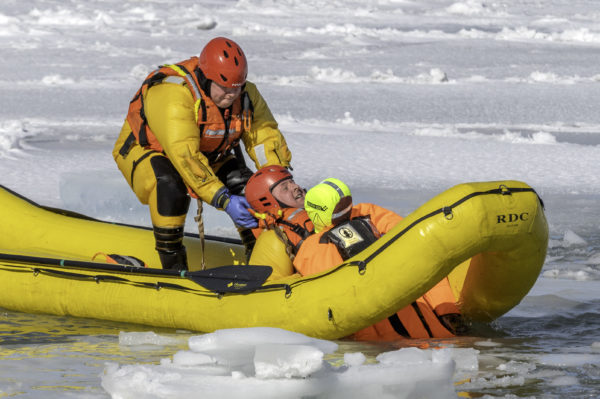
By Tristan Marks
NewsNow
Members of the Lincoln Fire Rescue (LFR) took to the icy shores of Lake Ontario last week for several days of cold water rescue training.
From Thursday to Saturday, the firefighters sharpened their critical rescue skills in practice scenarios both from the shore and on the water.
This seasonal training is key, even for the most experienced rescuer, said LFR trainer Don Sherren, who has 25 years of experience as an instructor under his belt.
“These skills are perishable so you have to constantly keep them sharp,” Sherren said.
“In a rescue situation on the ice, you have to act fast. Hypothermia can set in in a matter of seconds.”
On the lake, rescuers work ing teams of seven: two primary rescuers, two back-ups, two “shore-tenders” who provide support without entering the water at any point and a team commander who oversees the whole operation.
The team size is no arbitrary number. As Sherren explained, rescue team roles are that way so that “redundancies are built right into the system.”
“Most rescues occur with one or two firefighters in the water,” Sherren said. “We always have an extra firefighter for each rescuer incase something goes wrong with the first rescuer. We have team members who can pull a rescuer out while others can continue rescuing the original victim.”
Dressed up in full thermo-insulated suits, the trainees make use of two key pieces of equipment: the Fortuna, an inflatable raft that remains tethered to the shore; and a MARSAR ring, a floating ring that can be thrown out to victims closer enough to the shoreline.
The ‘victim’ in need of rescue during this training was a mannikin, who weighs “95 pounds of dead weight”. Sherren said this challenge is intention for the purposes of training.
“It (the mannikin) actually helps the training because the firefighter has to do all the work,” he said.
“A living person instinctively tries to help the firefighter as they are pulled out of the water.”
He said that victims are not always conscious or mobile during a real rescue.
In addition to winter training, LFR also conducts open water training in the summer. Firefighters must first pass a swim test undertaken at one of Lincoln’s public pools.
After demonstrating basic swimming capabilities, they undergo 8-12 hours of theory training, learning about team role duties, how to operate rescue equipment and so on.
Deputy fire chief Bill Blake said LFR firefighters perform about 5-10 water rescues per year.
All inland water-based rescues are coordinated between the host district and the water/ice water rescue teams from either Vineland or Jordan stations. For rescues in large, open bodies of water such as Lake Ontario and the Jordan Harbour firefighters will work in conjunction with GAMRU, NRP, and the Coast Guard.

